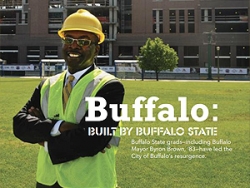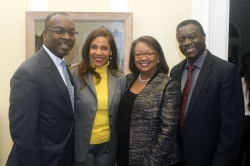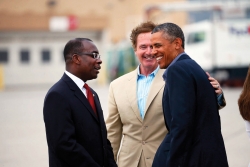Buffalo is back! Last July, the Washington Post announced it to the world.
An article in the venerable newspaper, titled “In Buffalo, N.Y., a new vitality is giving the once-gritty city wings,” detailed the city’s resurgence as both a regional economic center and a travel destination. The piece has been posted on Facebook and e-mailed by Buffalovers everywhere since its publication.
Of course, the city’s resurgence has not happened overnight. For the past decade, politicians and the private sector have joined forces to reimagine Buffalo and strategically plan for its growth.
While many alumni from Buffalo State College have made major contributions to that process, Buffalo Mayor Byron Brown, ’83, has played a leading role.
Brown was elected mayor in November 2005 and sworn into office on December 31 of that year. On his inauguration day, he toured the Buffalo waterfront and vowed that the once-neglected area would become a focal point for development.
In the 10 years since Brown’s inauguration, the Canalside district has become a major attraction and, as the Washington Post article wrote, “cranes all around town” are building the new Buffalo under the Buffalo State grad’s watchful eye.
Recently, Mayor Brown sat down with 1300 Elmwood to discuss Buffalo’s resurgence, his leadership philosophy, his friendship with Congressman Brian Higgins, ’85, and his years on campus as a Buffalo State student.
The City of Buffalo is in the midst of a well-documented renaissance. Many players have been involved in the city’s growth, but you have been leading the process and laying the groundwork since you became mayor in 2005. How does it feel to watch all the hard work pay off?
 Everyone in Buffalo and across Western New York is excited about this renaissance. I’m certainly proud, as mayor, to play a role in shaping the city.
Everyone in Buffalo and across Western New York is excited about this renaissance. I’m certainly proud, as mayor, to play a role in shaping the city.
When we developed a strategic plan for the turnaround of the city, we initially focused on three core ideas: (1) stabilize the city’s finances, create an environment for business investment, and create jobs; (2) improve the quality of life, including infrastructure, public safety, arts, culture, and public education; and (3) make government more efficient and establish relationships with residents. We wanted to become partners with residents and the private sector.
When our team came in 10 years ago, the city had high tax rates, a state-imposed fiscal control board, and vacant properties, and it had been bleeding population since the 1950s. We had some major challenges to address.
To begin that process, we felt it was critically important to go into the community and spend time establishing the trust of residents, and build positive relationships with City Council, state legislature, the governor, Congress. In terms of my involvement, that’s where it started.
What point are we at in the “renaissance”? And what’s the point at which we say “we’re there” or “we’ve made it.”
We’re a number of years into the process and we’ve seen results, but the renaissance hasn’t fully taken hold or blossomed yet. There’s more work to do. We can’t stop working. That’s not my personality type. I’m not one to rest on my laurels. We’re working full speed every day to help business grow and to improve the city.
What do you think the City of Buffalo will look like in 2025?
I think it will be even safer. There will be more investment in downtown. We’re working hard on that every day. Our finances are stronger than they have been in a long time, and that makes our future brighter. And, for the first time since the 1950s, we have census population growth. That is very exciting.
So, yes, by 2025, I think you’ll see a significantly different city. A city with a very strong residential community, retail activity, and mixed-use development. Downtown Buffalo will be the hottest spot in the region between New York City and Toronto.
And I think you may see a football stadium downtown. The Pegulas have a strong sense of social responsibility, and I know they are committed to Buffalo. We’re fortunate to be able to work with them.
Young people are staying in or moving to Buffalo—is that the ultimate sign of success?
That’s a big sign of success. We’ve always had an “attract and retain” goal—attract new residents and retain our own talent. In the past, many young people left to go elsewhere. Now, they’re coming back as the word gets out about opportunities here.
From a young age, you were recognized as a leader. Ebony magazine named you to its “30 Leaders of the Future” list when you were 30 years old and still several years away from your first run for public office. What makes someone a leader? And what does it take to go from having ideas or vision to being able to implement those ideas?
My personal view of a leader is this: someone who is willing to roll up his or her sleeves and work hard. Someone who is consistent in his work and has a positive attitude. A good leader will listen to the thoughts and ideas of others and be responsive to situations. There is always a need for leadership and new leaders—and they should have the ability to be strategic and the willingness to take responsibility for their actions. It’s all about doing your level best.
To what extent can leadership be taught or learned? Is it an innate quality?
 Both. Many leaders are born with innate qualities; others prepare through training and hard work. A leader can be born or made. Experience is very important, as is surrounding yourself with talented people and being willing to listen and learn from others.
Both. Many leaders are born with innate qualities; others prepare through training and hard work. A leader can be born or made. Experience is very important, as is surrounding yourself with talented people and being willing to listen and learn from others.
You grew up in Queens. What attracted you to Buffalo and to Buffalo State College? I’ve heard your admiration for Randy Smith had something to do with it.
Yes, I played basketball in high school and thought, “Where could I go to college in a city with a professional basketball team?” I did some research and identified Buffalo State. Randy Smith went to Buffalo State, of course, and he was from Long Island, not too far from where I grew up. And he had gone on to a great college and pro career. So, I wanted to do that, too.
It didn’t hurt that Buffalo State offered an excellent educational environment and was affordable to my parents.
I didn’t calculate that I did not have near the athletic talent needed to be a star player in college or the pros. I played one year of JV basketball—and every now and then, the team photo with all of us in the short basketball shorts will surface.
I should add that I’ve had a few opportunities to speak with President Obama over the years at various events, and I let him know that I can play point guard in case he ever needs me for a pickup game.
Did you ever imagine during your college years that you’d be serving as the mayor of this city or even working in public office? Do you think your family ever imagined that?
No. I was originally a biology major. I had the opportunity to intern at the Western New York Children’s Psychiatric Center in West Seneca, and I thought for a time about going to med school for psychology. At same time, though, I was developing an interest in student government. I became president of my fraternity and an officer in SGA and the Inter-Greek Association. That led to a larger interest in politics.
Ultimately, I majored in journalism with a concentration in public relations. And I was hired for my first job in public service by George K. Arthur, who was the Common Council president. I purchased my first house in Buffalo and just fell in love with the city.
But, no, during college, I never imagined that I would be mayor someday. And I don’t think my family ever imagined that, either. My parents were always proud of me, and we’d talk about what I was doing and what I had accomplished in college, but they weren’t expecting me to be mayor.
One of your partners in this renaissance, Representative Brian Higgins, Class of 1985, is a fellow Buffalo State political science major. Did you have any classes together back then?
 We were never in class together, but our paths have crossed in a lot of ways over the years. He was a City Council staffer before me. And then we were County Legislature staffers at the same time.
We were never in class together, but our paths have crossed in a lot of ways over the years. He was a City Council staffer before me. And then we were County Legislature staffers at the same time.
Brian was then elected to the New York State Assembly, and I followed in the State Senate.
We’ve been colleagues and friends for a long time now, and we get together for lunch from time to time to talk about ideas. It’s been great to work with him, and we share the Buffalo State pride.
Where does Buffalo State fit in, in terms of preparing the next generation of community leaders and citizens?
Higher education is so important in preparing our leaders of the future. In that respect, Buffalo State College has a very important place.
In my own experience, Buffalo State provides a safe, nurturing environment. The faculty is supportive and encourages students to learn everything they can and reach their full potential.
Buffalo State’s public mission provides an environment that works for students at different levels—from the highest-achieving students to those who may need some academic support.
I have no doubt that Buffalo State will continue to produce strong graduates who can move this city forward.
Pictured:
Top: Mayor Brown at the inauguration of Buffalo State President Katherine Conway-Turner, October 2014.
Second from top: Mayor Brown, photo courtesy of Mayor's Office, City of Buffalo.
Third from top: Mayor Brown and his wife, Michelle, with Buffalo State President Katherine Conway-Turner and her husband, Dr. Alvin Turner.
Bottom: Mayor Brown and Congressman Higgins welcome President Barack Obama to Buffalo in 2013.
This piece first appeared in 1300 Elmwood, the magazine for alumni and friends of the college.